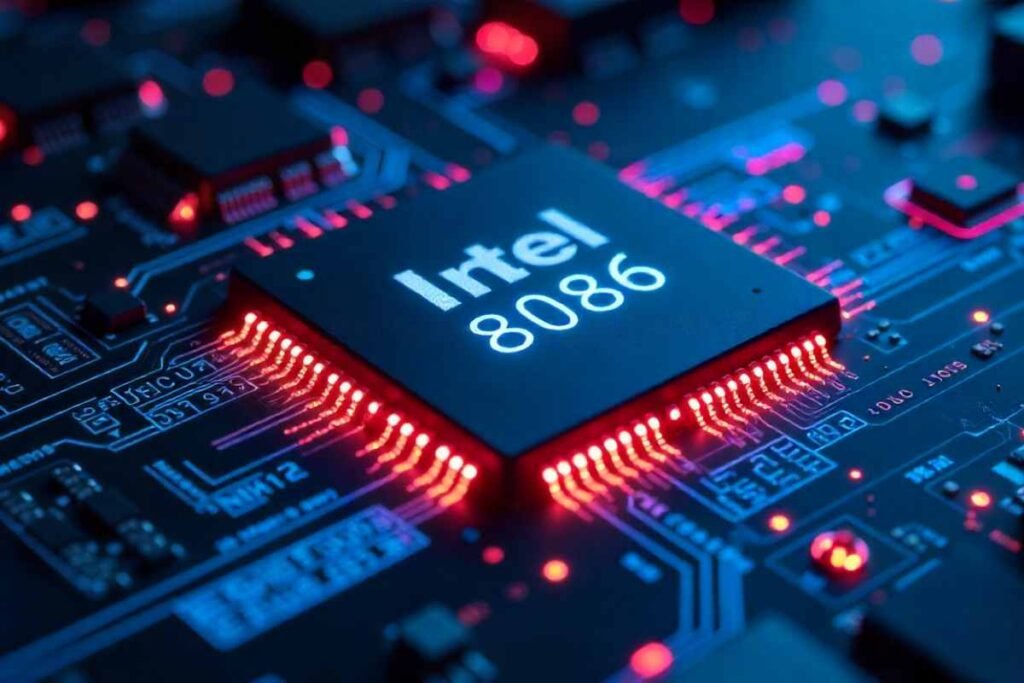The instruction set of 8086 is the collection of commands used by the Intel 8086 microprocessor to perform various tasks such as data transfer arithmetic logical operations and control functions. These instructions are written in assembly language and converted into machine code for the processor to execute.
Understanding the instruction set of 8086 is essential for students developers and professionals dealing with microprocessors or embedded systems. It forms the foundation of low-level programming helps in optimizing performance and provides a strong base for learning modern CPU architectures.
What is the Instruction Set of 8086?

The instruction set of 8086 consists of commands that control the operations of the Intel 8086 microprocessor. These instructions are written in assembly language and are converted into machine code. Each instruction generally contains an operation code opcode and in some cases operands. With its 16 bit architecture the 8086 microprocessor supports multiple instruction categories making it one of the most influential processors in computing history.
Understanding the 8086 Instruction Set Architecture
The instruction set of 8086 forms the foundation of its operations, defining how the processor interacts with data memory and peripherals. The architecture supports a variety of instructions grouped based on their purpose such as data transfer arithmetic logical control and string operations. Each instruction performs a specific function that contributes to efficient program execution artificial-intelligence-trends/.
In 2025, the instruction set still holds great academic and technical relevance. Understanding these instructions helps students, engineers, and professionals build optimized assembly programs and improve system performance. As technology evolves knowledge of this architecture remains critical for computer engineers.
Importance of the Instruction Set of 8086
Mastering the instruction set of 8086 offers numerous benefits. It allows developers to create optimized programs that run efficiently enhances hardware-level control and builds a solid foundation for understanding modern processor architecture. Without this knowledge working on low-level system programming and microprocessor-based projects becomes extremely challenging.
Types of Instructions in the 8086 Instruction Set?
The instruction set of 8086 is divided into various categories that handle specific tasks.
Data Transfer Instructions
These instructions allow data movement between registers memory and I/O ports. For example the MOV command transfers data efficiently while XCHG swaps values between two locations. Commands like IN and OUT are used for input and output operations.
Arithmetic Instructions
These instructions handle mathematical computations. Common examples include ADD for addition SUB for subtraction, MUL for multiplication and DIV for division. These operations are essential for creating algorithms and executing logical calculations.
Logical Instructions
Logical instructions such as AND OR XOR and NOT allow bitwise operations and decision-making processes within programs. The TEST instruction checks specific bits without modifying the data which is useful in conditional programming.
Control Transfer Instructions
These instructions modify the sequence of program execution. The JMP command performs unconditional jumps while CALL and RET manage subroutine handling. Conditional jumps like JE and JNE execute code blocks based on flag values.
String Instructions
The instruction set of 8086 supports dedicated string handling commands including MOVS CMPS SCAS and LODS. These are ideal for processing blocks of text or data efficiently.
Addressing Modes in the 8086 Instruction Set?
Addressing modes define how operands are accessed in an instruction.
Immediate Addressing
The operand value is specified directly in the instruction such as MOV AX 1234H.
Register Addressing
Operands are located within processor registers which provide faster access and execution.
Direct Addressing
The instruction specifies the exact memory location for example MOV AX [5000H].
Indexed and Based Addressing
These advanced modes calculate effective addresses using register values making them suitable for working with arrays and data structures.
Role of the Instruction Set in Program Execution

The instruction set of 8086 plays a central role in determining how a program executes on the microprocessor. Each instruction translates into machine code that the CPU interprets and executes step by step. The efficiency of the instruction set ensures smooth performance, especially in applications where timing and speed are crucial.
For example, data transfer instructions move values quickly between registers, while arithmetic operations execute mathematical tasks seamlessly. The ability to combine instructions into meaningful sequences enables programmers to develop efficient, high-performance software.
Step by Step Guide to Writing 8086 Assembly Programs?
Understand the Problem
Analyze the requirements of the program and break them down into smaller tasks.
Choose Appropriate Instructions
Select commands from the instruction set of 8086 that efficiently execute each task.
Select Correct Addressing Modes
Use addressing modes that best suit the data storage method, ensuring efficient processing.
Compile and Test the Program
Assemble the code using an assembler then test the program using an emulator or hardware.
Applications of the 8086 Instruction Set in 2025
Even in 2025 the instruction set of 8086 remains relevant for understanding the foundation of modern computing. It is widely used in educational environments embedded systems, and legacy software development. Students and professionals still study the 8086 architecture to gain a deeper understanding of low-level programming and microprocessor design.
Additionally, many microcontrollers and hardware simulation platforms rely on concepts derived from the 8086 instruction set, making it an essential topic for computer science learners and hardware engineers alike.
Instruction Execution Cycle in the 8086
The execution cycle defines how the processor handles instructions:
- Fetch The instruction is retrieved from memory.
- Decode The CPU interprets the instruction.
- Execute The required operation is performed.
- Store The result is saved in memory or registers.
Understanding this cycle ensures efficient coding and debugging.
Data Transfer Instructions in the 8086 Microprocessor
Data transfer is a crucial function in any microprocessor, and the instruction set of 8086 includes a rich set of commands to facilitate efficient data movement between registers, memory, and I/O ports. Examples include MOV PUSH POP XCHG and IN/OUT instructions.
These instructions ensure smooth communication between different components of the system. For example, the MOV instruction transfers data from one location to another without altering it, while PUSH and POP manage stack operations effectively. Mastering these operations is essential for building stable assembly programs.
Control Transfer and Branching Instructions

Control transfer instructions allow the program to make decisions, manage loops, and handle conditional execution effectively. In the instruction set of 8086, these include JMP CALL RET and conditional jump instructions like JE JNE JG and JL.
These instructions enable developers to design dynamic programs capable of responding to different runtime conditions. Proper implementation of branching improves code efficiency and prevents unnecessary computations.
Want to learn professional tips and advanced tricks about this topic? Click here and unlock our complete in-depth guide instantly!”
Staying Updated with Technorozen Latest Tech News
Technorozen Role in Bridging Complex Tech Concepts
Networking Opportunities through Technorozen Community
Conclusion
The instruction set of 8086 plays a vital role in understanding how the microprocessor operates and processes instructions efficiently. It provides a clear foundation for assembly language programming and gives insight into the internal working of the processor.
In 2025 the relevance of the instruction set of 8086 remains significant for learners and professionals aiming to strengthen their fundamentals in microprocessor architecture programming techniques and embedded system development.
FAQs
What is the instruction set of 8086?
It is the complete set of commands that the 8086 microprocessor can execute to perform various tasks.
Why is the instruction set of 8086 important?
It provides control over hardware operations and enables programmers to write efficient low-level programs.
How many instruction types are in the 8086?
Five main categories: data transfer, arithmetic, logical, control transfer, and string instructions.
What are addressing modes in the instruction set of 8086?
Addressing modes define how operands are accessed, including immediate direct register and indexed modes.
Is the instruction set of 8086 still relevant today?
Yes, it is widely used in education and serves as a foundation for modern processor design.
How to master the instruction set of 8086?
Practice writing assembly programs, analyze instruction execution, and focus on understanding addressing modes thoroughly.


